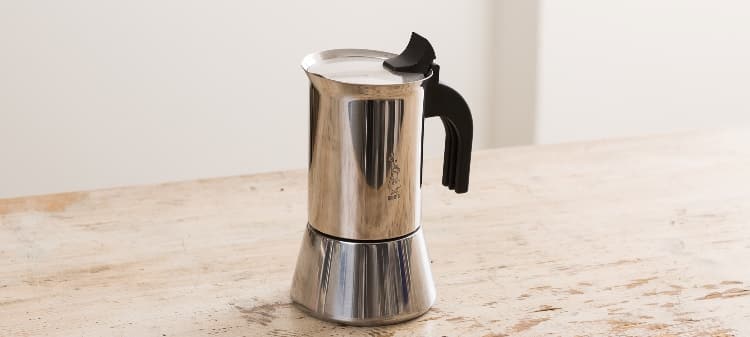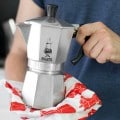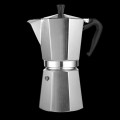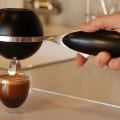When inventor Luigi De Ponti created the very first Moka Pot, he utilized aluminum as the main material and gave the contraption bakelite handles (as you may or may not know, this material is really similar to plastic but has an enormous resistance to heat and high temperatures). The design has remained the same since the pot’s birth in the early ‘30s. Nevertheless, technology kept on advancing and moving forward, and some new materials were introduced. Though the pot has an iconic shape and design that is strongly linked to the materials from which it is made, it currently has its challengers, the principal being stainless steel. So we had to further investigate. Is aluminum safe? Is it still used for mere nostalgia or it really serves a purpose health and coffee quality wise? Is stainless steel better? Is it worse? Stick with us for a little longer and you’ll see what we found out.
Before talking specifically about Moka Pots, let’s observe aluminum and stainless steel on their own, in more general terms.
Firstly We Have Aluminum
Generally inexpensive, it heats and cools ostensibly quicker than other metals, which may be relevant in some cases. It is also very light, but acidic foods have a quick negative effect on this material. The long term consequence is that the different chemical reactions different types of food can have when placed on an aluminum pot or pan will eventually etch and warp this containers, rendering them useless. Then again, because of aluminum’s low cost, they can be eventually easily replaced.
Here are a few of our favorite Aluminum moka pots.
The Original Bialetti Moka Express Made in Italy 6-Cup Stovetop Espresso Maker with Patented ValveRoast Italian Espresso Coffee Maker Moka Pot Express – 6 Espresso-Cup, Rubber Handle, Rounded BasePrimula Today Mario Espresso Maker – Aluminum – For Bold, Full Body Espresso – Easy to Use – Makes 6 Cups
Secondly There is Stainless Steel
Sturdier and heavier than aluminum, it takes a little longer to gain heat but it also takes more time to get cool. Though it is more expensive than aluminum, is more durable. On the long run, stainless steel is the most cost effective. Once again acidic foods are to be avoided as much as possible, just because these chemicals can break the protective surface of these pots and pans.
Here are a few of our favorite stainless steel moka pots.
Venus Espresso Coffee Maker, Stainless Steel, 4 cupBialetti 06812 Kitty Coffee Maker, Stainless Steel, 4-Cup(8 oz)Primula Stainless Steel Stovetop Espresso Maker
What Type of Stovetop Espresso Maker is Best?
To be more specific, what people say about these two materials in relation to a Moka Pot is that one of them leaves more of a metallic aftertaste in the coffee it brews whereas the other one preserves in a more satisfying way the original taste of your coffee beans.
Several “studies” can be found all over the Internet advocating for one metal or the other. The people that root for the stainless steel generally play the health card, whereas the ones who prefer aluminum appeal to one’s nostalgia and the fact that the aluminum pots are much classier looking (or so they say).
While it is true that the aluminum pot has a great, classic design, what can we say about the rumor that this specific type of metal is bad for your health? At least when it comes to these stove top coffee makers, any health hazard can be avoided by taking proper care of your pot, and keeping in mind a few useful tips. There are plenty of resources online, and Moka Pot care is a topic we have covered in the past. Nevertheless, it all boils down to understanding your device, keeping it clean, dry and keeping an eye on the oily coating in the inside of the pot; it may go rancid if left alone for a long time.
You may think we are repeating ourselves or we do not keep track of the information we periodically provide for you. This is, of course, not true. We simply take for a fact something a lot of people like to pass as the opposite: taste is not universal. By this we mean that what for some people may be delicious, for others can be too acid or too bitter. Coffee has a lot of lovers worldwide because it is a versatile beverage that can be adapted to every user’s particular taste. So don’t limit yourself. Try an aluminum Moka Pot. Try a stainless steel one. Try a pour over method. Try espresso. Try. The only way you can go wrong, at least when it comes to coffee, is to not try at all.
I honestly cannot say if one of these two materials is better. One is cheaper, one lasts longer. Both are metal, so the risk of a metallic aftertaste will be there one way or another (but now you know how to avoid it). The aluminum version has been on the market since the ‘30s. The stainless steel one is a product of our time. Maybe it is time for us to find a balance. To learn and appreciate the different facets a cup of coffee can have and how the method we use for brewing it affects them.
If you would like to continue reading and informing yourself on this subject, try the following resources: http://www.espresso-machines-and-coffee-makers.com/stove-top-espresso-maker.html, http://jeffwerner.ca/blog/2013/02/bialetti-showdown/. Happy drinking!







